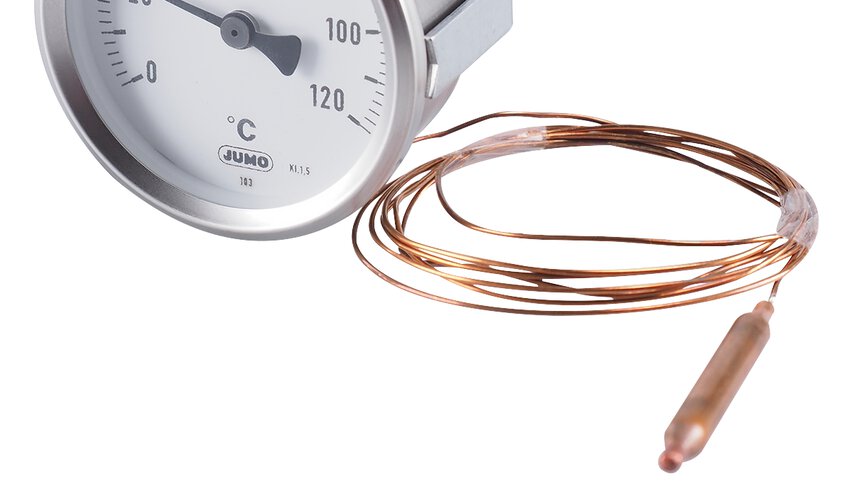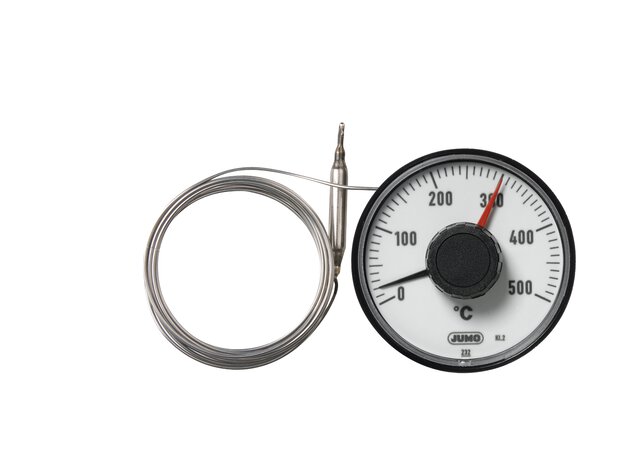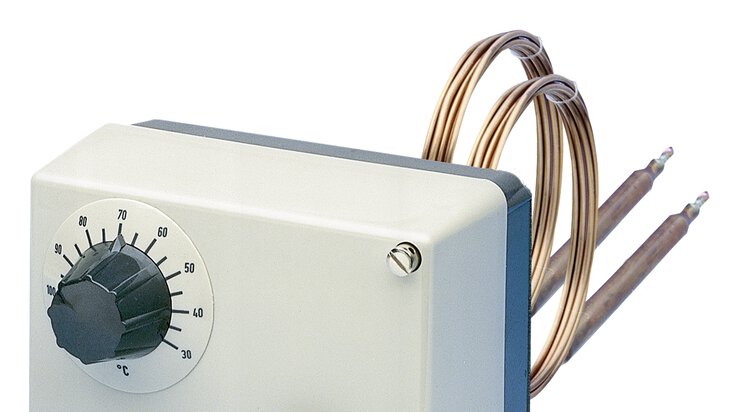

Capillary thermometer – how to choose?
Capillary thermometers have many advantages, including the ability to take measurements in hard-to-reach places, even in the smallest pipelines. In the following entry, we explain what a capillary thermometer is, how it is constructed and tell you how to choose the right one for your application.
Capillary thermometer – what is it?
Capillary thermometers measures the process temperature at at hard-to-reach points. This thermometer can be integrated in an instrument panel (fastening for example with elastic tabs), a switch cabinet or a control panel.
Capillary thermometer – construction
The capillary tube can only be connected to a gas thermometer, it is not present in bimetallic thermometers.
The elements of a capillary thermometer are:
- Sensing bulb: the element in direct contact with the heat source. It can be made of copper or brass, depending on the temperature to be measured.
- Capillary: A "cable" of perforated copper that connects the bulb and the spiral. A synthetic liquid flows inside. Based on the temperature range to be measured, the length of the capillary is calculated according to the viscosity rules of the liquid. The temperature is measured by a measuring head placed at the end of the capillary tube.
- Spiral: this element is made of copper and connected to one end of the capillary. It allows movement based on the heat transferred through the bulb to the spiral and consequently to the reading indicator (pointer).

Thermometer with capillary tube JUMO MICROSTAT-M
How do I choose a capillary thermometer?
To choose the right capillary thermometer for your application, you need to determine:
-
scale range
-
the length of the capillary
-
type of sensor connection
Capillary thermometers – advantages
With a dial thermometer with a capillary, it is possible to measure temperatures in inaccessible points. Even the smallest pipes can be reached by means of the contact bulb. Another advantage is the bridging of larger distances, so that this type of thermometer can be centrally integrated into a control cabinet, switchboard or control panel.
Where is the capillary thermometer used?
The capillary thermometer is used in areas such as:
- refrigeration
- gastronomy
- domestic appliances

Gastronomy – one of the industries where capillary thermometers are used
Repair of a thermometer with a capillary tube
It sometimes happens that the liquid in the glass tube (capillary) separates during transport. You can force the liquid to reconnect by shaking the thermometer firmly in a downward direction.
Capillaries
A capillary is a very thin glass tube, inside of which a synthetic liquid flows. Under the influence of temperature changes its volume, which causes the pointer to bend on the background of the thermometer's dial with the temperature scale.
Capillary – measurement principle
Temperature measurement is based on the phenomenon of expansion of the liquid placed in the capillary tube. The temperature is read by a sensor, placed at the end of the capillar
Dial thermometer for measuring temperature
Analogue dial thermometer with a capillary is used to measure temperature of liquids, gases and solids. It is characterised by high reliability of operation. Thanks to the capillary, remote reading is possible.

Dial thermometer with capillary
Capillary thermostat
The capillary thermostat is used to control electrical equipment, such as heaters or blowers, in temperature control systems. Thermostats are used to maintain the temperature at a constant level or to monitor it in order to prevent overheating of components.
Measuring principle of a thermostat with a capillary tube
The measuring principle is based on the expansion of fluids under the influence of heat. The fluid is enclosed in a metal tube and expands or contracts when the temperature changes. The change in temperature of the fluid causes a diaphragm to move, which makes contact with the snap switch and opens or closes the circuit. This results in a very accurate measurement.
Thermostat capillary
The sensors in the thermostat are connected via a capillary. Based on the set temperature, the sensor closes when the temperature rises and opens when the temperature falls.

Thermostat with capillary JUMO ATH
JUMO Capillary thermometers and thermostats
JUMO offers a wide range of capillary thermometers and thermostats, e.g. the universal capillary thermometer and the explosion-proof capillary thermostat for zones 1 and 21: 1 and 21. Contact us - we will select the right thermometer for your application!
- ${title}${badge}

